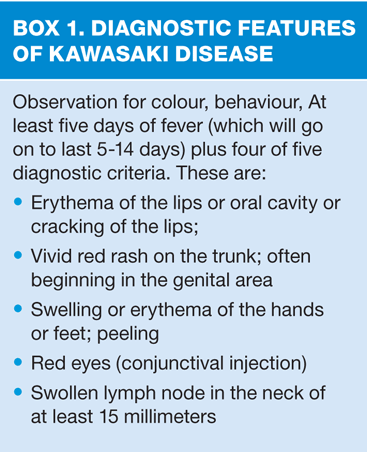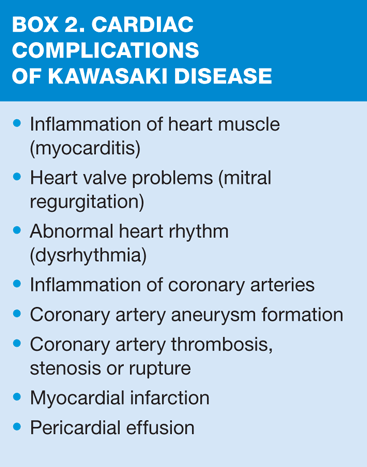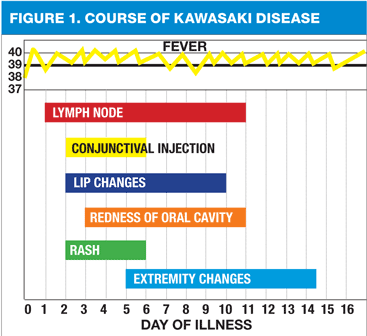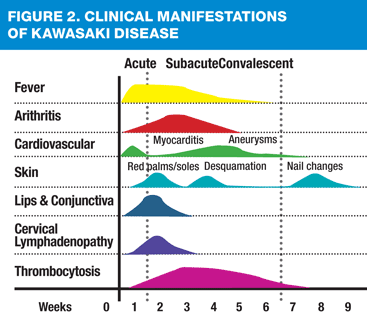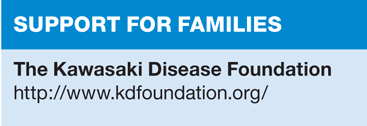Infectious diseases in children: Kawasaki disease
Dr Mary Lowth
Dr Mary Lowth
MA MB BChir FRCGP PGCME
GP and medical educationalist
Every practice nurse who sees sick children in primary care needs to know about Kawasaki disease and to consider this difficult-to-make diagnosis every time a child presents with fever
Kawasaki disease presents to us rarely in the UK, but it's a diagnosis that we must not miss, as if left untreated it is the leading cause of serious and even fatal heart disease in children.1,2
The diagnostic difficulty is significant, as early signs and symptoms are non-specific. Unfortunately, by the time the disease has become obvious the chance for effective intervention is lost.
It needs considerable alertness to spot rare diseases that don't have clear presentations. Our best preparation is to keep it in the forefront of our minds, and consider it every time we see a feverish child.
HISTORY
A Japanese paediatrician, Tomisaku Kawasaki, first described the disease in 1960. He had no idea what it was, and is said to have filed his descriptions in a folder called GOK, which meant 'God Only Knows'. He published the first description in 1967.
WHAT IS IT?
The significant feature of Kawasaki disease is a vasculitis of unknown cause. Vasculitis is inflammation of the walls of blood vessels — in this case inflammation of small and medium sized arteries throughout the body. Crucially this includes the coronary arteries which supply oxygen to heart muscle.
Kawasaki also affects skin, lymph nodes and mucous membranes, and this combination gives rise to the other diagnostic signs and to its other name of mucocutaneous syndrome.
WHAT CAUSES IT?
The causative agent of Kawasaki disease is unknown but it is probably an infectious agent that triggers an immune response. North-East Asian children are more susceptible and researchers believe that a particular antigen, HLA-Bw22J2, which is found mainly in Japanese populations, may be involved.3
One theory postulates a windborne pathogen and points to clusters associated with certain weather patterns.4
The highest annual incidence is in Japan at 120-180 cases per 100,000 children under 5 years. This appears to be rising.5—7 The higher incidence in North East Asian children persists even if they grow up in countries with low incidence.
Analysis of English statistics suggests we have about 8 cases per 100,000 children under 5 each year, and a few more in over 5s. This means between 200 and 300 cases per year in total (compared with around 1,000 for meningitis).
Just under three-quarters of affected children are under 5 years old and the male to female ratio is between 1.3 and 1.5 to 1. Boys under 1 year and over 8 years have a slightly worse prognosis.
MORTALITY
Up to a quarter of untreated children develop significant aneurysms of their coronary arteries, and about 1 in 100 die as a consequence. With early treatment the chances of death are greatly reduced. Kawasaki disease has a mortality of 0.1% in Japan, where it is common and well recognised. In the UK, the mortality is over 2%,2,7 the same as the mortality in Japan in 1960.
We should be worried by these figures, which occur because parents and health care professionals don't think about this rare condition soon enough. Consciousness in parents of the condition is also very low (think how aware patients are of meningitis in children, by contrast).
DIAGNOSTIC FEATURES: EARLY
Kawasaki disease presents with a red rash and fever, which may be initially indistinguishable from other lesser causes of fever and rash such as roseola, fifth disease, measles, rubella and even meningococcal disease. Conjunctivitis is also common.
The fever is very prolonged, and more clearly diagnostic signs (box 1) arise later — however, the window for treatment is while the symptoms are still relatively non-specific.
There is no specific test; clinical diagnosis is based on symptoms and physical findings. You should suspect Kawasaki disease if you see:
- Fever that lasts for five or more days (this reduces the likely diagnoses right down, ruling out most common viral infections and leaving just a few such as scarlet fever and roseola, together with persistent purulent infections such as otitis media and urinary tract infection)
- Uncomfortable irritable child (this would be expected with such a fever)
- Rash, often worse in the groin area (this is also true of scarlet fever, roseola and measles. Children with measles also have a cough. Children with roseola are well at this stage. Children with scarlet fever have tonsillitis or occasionally impetigo).
- Red bloodshot eyes, without drainage or crusting (normal infective conjunctivitis includes a sticky yellow discharge, and allergic conjunctivitis causes clear discharge)
- Bright red, swollen, cracked lips (this may be seen in primary herpes simplex and Stevens Johnson syndrome(SJS), but herpes does not usually show the prolonged fever, and in SJS the mouth symptoms predominate)
- Strawberry tongue (this is seen in many childhood viral illnesses and in scarlet fever)
- Swollen hands and feet (this is unusual but occurs almost at the very last opportunity for treatment that prevents cardiac complications. Peeling occurs afterwards, but by then the window of opportunity for effective treatment may have been missed.)
- Redness of the palms and soles of the feet (likewise)
- Swollen lymph nodes in the neck (a nonspecific sign, although there is often a single large lymph node)
Diagnosis largely is a process of looking for these symptoms and ruling out diseases that cause similar signs and symptoms, including:
- Scarlet fever, which is caused by streptococcal bacteria and results in fever, rash, chills and sore throat
- Juvenile rheumatoid arthritis
- Parvovirus B19 (slapped cheek disease)
- Stevens-Johnson syndrome, a disorder of the mucous membranes
- Staphylococcal toxic shock syndrome
- Measles
- Certain tick-borne illnesses, such as Rocky Mountain spotted fever
DIAGNOSTIC FEATURES: COURSE OF DISEASE
Kawasaki disease symptoms appear in phases. See Figures 19 and 210
First phase
Signs and symptoms of the first phase may include:
- Fever > 38.5 C, which will last for 5-14 days
- Conjunctivitis (marked) without discharge
- A truncal rash often starting in the genital area
- Red, dry, cracked lips
- Strawberry tongue
- Swollen, red skin on the palms and soles
- Swollen lymph nodes in the neck and perhaps elsewhere
- Irritability
- Enlarged liver and jaundice can occur
- Tachycardia may be present
Second phase
In the second phase, when the window for effective treatment is just about passed, we see
- Peeling of the skin on the hands and feet, especially the tips of the fingers and toes, often in large sheets
- Joint pain
- Diarrhoea
- Vomiting
- Abdominal pain
- Mild anaemia
- Mild proteinuria
- Thrombocytosis
- Joint pains
Third phase
In the third phase signs and symptoms fade although it may be as long as eight weeks before energy levels seem normal again.
SEQUELAE
Without treatment, around 50% of children show echocardiographic evidence of cardiac impairment and mild mitral regurgitation, although they may be asymptomatic. About 25% of children develop heart disease involving the coronary arteries (see box 2), although many smaller aneurysms disappear within two years.
Coronary artery aneurysms are more likely in boys aged under 1 year, over 8 years, or in those who suffer prolonged fever (>14 days) who presumably have a more severe inflammatory process.
Cardiac aneurysms cause small areas of stasis in blood flow, leading to clot formation and acute blockage. Vessel wall inflammation also increases the tendency for clot formation due to production of inflammatory substances to promote healing.
With treatment complication rates drop to 1-10%. Doctors follow up all children including those who do not appear to have coronary involvement, usually with echocardiograms. Other longer-term consequences (e.g., non-coronary) are extremely rare.
MANAGEMENT IN PRIMARY CARE
If Kawasaki disease is suspected children should be admitted to hospital for further care, without delay.
Assessment of a child with fever
NICE8 states that children with feverish illness should be assessed for the presence or absence of symptoms and signs that predict risk of serious illness — the so-called traffic light system. Prolonged fever for more than 5 days is on this list as 'amber', suggesting that the child needs paediatric review.
NICE also states you should admit a child if the child's fever has no obvious cause but is lasting longer than you would expect for a self-limiting illness.
Box 2 offers some help and guidance in distinguishing some of the differential diagnoses for prolonged fever in children.
Treatment and follow up
This is a specialist area: Kawasaki disease is not treated in primary care. However, if the practice has an affected family they may well consult about other things and it can be helpful to have an understanding of how Kawasaki is managed.
The only effective treatment is intravenous injection of human immunoglobulin G, which is the main antibody fraction in blood. This lowers the probability of aneurysms from 25% to under 5%. The mechanism is not understood. Immunoglobulin also reduces inflammation and relieves symptoms. Children are treated intravenously if the disease is suspected, with:
- Gamma globulin infusion can lower the risk of coronary artery problems. Clinical improvement begins almost as soon as treatment begins.
- Aspirin High doses may help treat inflammation. Aspirin can also decrease pain and joint inflammation, as well as reduce the fever. Kawasaki treatment is a rare exception to the rule against aspirin use in children.
- Steroids are occasionally used but the evidence for them is not clear.
After the initial treatment
Once the fever goes down, children are given low-dose aspirin for as long as six to eight weeks, and longer if they develops a coronary artery aneurysm.
Aspirin in children has been linked to Reye's syndrome, a rare but serious illness that can affect children and teenagers after a viral infection. This means that children who develop viral illnesses during Kawasaki treatment need to stop taking aspirin.
Monitoring heart problems
Children who have had KD are followed up. The only known sequelae are cardiac so follow up involves cardiac surveillance, usually by echocardiography, to look for signs of damage.
If aneurysms are present the child has an increased risk of myocardial infarction (MI) and so treatment with anticoagulants is first line, together with curative procedures such as angioplasty, stent placement and bypass grafting if damage is significant.
DIAGNOSTIC SIEVING
Not missing rare but serious diseases involves thinking of them and actively ruling them out every single time you see a child with a fever.
This means we need to use a diagnostic sieve when you see a child with a rash. We must mentally shake the child through the sieve to catch those who might have serious disease. In practical terms this means thinking about those serious diseases in every child. That's what forms the sieve. This is in contrast to a pure diagnostic approach, which involves adding up symptoms until you reach a most likely diagnosis.
When it comes to serious conditions, though, then even if they are not the most likely diagnosis, we are interested in knowing that they are on the 'possibles' list.
Remember not to EXCLUDE Kawasaki just because you don't see peeling hands and feet. You can see from the tables and descriptions above that this is a later sign.
Every time we see a child with a fever or rash we have to ask ourselves:
1. Am I as sure as I can be that this child does not have Kawasaki disease, meningococcal disease or measles? Look for what rules it in and what rules it out.
2. Even though I am sure of this today should I review this child tomorrow or later in order to be more sure?
We then need to safety net so that if things change the parents will return. The best way of doing this involves giving them guidance on what to expect if you are right and their child has a mild condition which requires no further intervention — and making it clear to the parent that if progress departs from this (or if a fever continues unexpectedly) then you would like to see the child again.
Only in this way are you likely to catch this disease, which you may see only once but, if you miss it, you will remember forever.
CONCLUSION
Kawasaki disease is rare and most practice nurses will never see it. However, it does seem to be increasing, and its seriousness means that we need to retain an awareness of it as a possible cause for fever. If you remember nothing else than the possible seriousness of a 5-day fever you are on the right track!
REFERENCES
1. GP notebook on Kawasaki disease http://www.gpnotebook.co.uk/simplepage.cfm?ID=1751842816
2. Kawasaki disease on patient.co.uk http://www.patient.co.uk/doctor/kawasaki-disease accessed 24/7/13
3. Satter E, Dermatologic Manifestations of Kawasaki Disease, Medscape, Jun 2011
4. Frazer J, Infectious disease: blowing in the wind : The mysterious Kawasaki disease might cross the Pacific on air currents high in the atmosphere.: Nature 484: 7392 4 April 2012 http://www.nature.com/news/infectious-disease-blowing-in-the-wind-1.10374 accessed 22/7/12
5. Nakamura Y, Yashiro M, Uehara R, et al; Epidemiologic features of Kawasaki disease in Japan: results from the nationwide survey in 2005-2006. J Epidemiol. 2008;18(4):167-72.
6. Watts RA, Lane S, Scott DG; What is known about the epidemiology of the vasculitides? Best Pract Res Clin Rheumatol. 2005 Apr;19(2):191-207.
7. Harnden A, Takahashi M, Burgner D; Kawasaki disease. BMJ. 2009 May 5;338:p1514.
8. NICE (May 2007). Feverish illness in children Assessment and initial management in children younger than 5 years
9. Ateneo school of Public Health medicine http://dc151.4shared.com/doc/j3a0lXJn/preview.html accessed 28/7/13
10. www.wikipedia.org
Related articles
View all Articles
